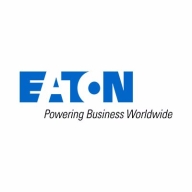
![Schneider Electric-APC Smart-UPS VT [EOL] Logo](https://images.peerspot.com/image/upload/c_scale,dpr_3.0,f_auto,q_100,w_64/nMofwdfqGZNhysBhU3KSto7z.jpg)
Schneider Electric-APC Smart-UPS VT and Eaton UPS are competing in the uninterruptible power supply market. Schneider Electric-APC Smart-UPS VT holds an edge in customer support and ease of deployment, while Eaton UPS offers better features and pricing.
Features: Schneider Electric-APC Smart-UPS VT offers a highly scalable architecture, advanced manageability, and robust reliability for critical load protection. Eaton UPS includes superior energy efficiency, innovative battery management, and user-friendly touch-screen functionality, enhancing its operational efficiency.
Room for Improvement: Schneider Electric-APC Smart-UPS VT could benefit from cost reduction, improved energy efficiency, and advanced monitoring features. Eaton UPS might improve in customer interaction experience, installation service, and touch-screen responsiveness under certain conditions.
Ease of Deployment and Customer Service: Schneider Electric-APC Smart-UPS VT is recognized for straightforward installation and excellent customer service. Eaton UPS offers comprehensive installation services, yet there is room for improvement in customer interaction and technical support response time.
Pricing and ROI: Schneider Electric-APC Smart-UPS VT has a higher initial cost, offering solid ROI through reliability and customer support. Eaton UPS offers a cost-effective solution with upfront savings, compelling energy savings, and reduced maintenance costs, making it appealing for budget-focused buyers.
| Company Size | Count |
|---|---|
| Small Business | 3 |
| Midsize Enterprise | 2 |
| Large Enterprise | 9 |
Eaton UPS is a power management provider that delivers a comprehensive portfolio of uninterruptible power supply, backup power, power distribution, and power management solutions, which protect you from a host of threats, including power outages, surges, and lightning strikes. Eaton’s offerings are designed to deliver superior flexibility, maximum efficiency, and unprecedented reliability for network closets, server rooms, and data centers of all sizes.
Eaton UPS Key Features
Eaton’s power quality portfolio encompasses a comprehensive offering of power management solutions all from a single-source provider.
Reviews from Real Users
Eaton UPS stands out among its competitors for a number of reasons. Several major ones are its extensive monitoring and reporting tools, its scalability, and that it is a stable and very reliable product.
Brad G., a technical services manager at a government company, notes, “The fact that they're reliable and that they notify us whenever the line power drops are the only things we really need. All our UPS's have been available and up whenever power outages have happened. So far, the battery life, from my observation, seems better than average. It was one of the features that Eaton had described to us. They have a certain way of charging the batteries and keeping them charged so that they actually last longer.”
Juno C., a radiation oncologist at East Oregon Cancer Center, writes, "The battery life seems to be pretty good. I don't have a lot of experience with other units of its size, but it does a good job of keeping our unit up. There is no active power management. It just keeps the power up. We haven't had any power failures that are long enough to completely drain the battery. It's been good for small power failures. In addition, I can access the built-in webpage on the UPS and use that to look at the status. It's on all the time and monitoring. It gives us an email once a month telling us that our device is working properly. It will also list the power events that happened in that month."
Smart-UPS VT offers centralized three-phase power protection with the reliability of the award winning Smart-UPS family. Ideal for small data centers, large retail stores, regional offices, and dense power requirements, the Smart-UPS VT includes dual-mains input, automatic and maintenance bypasses, and scalable runtime with hot-swappable batteries for increased availability. The rack mounted version maximizes valuable floor space by incorporating UPS, power distribution, and additional battery capacity in a single rack. Low cost of ownership is achieved through best-in-class efficiency and a reduction in rating of electrical infrastructure - wires, transformers, and generators due the Smart-UPS VT's Soft Start feature. The APC Network Management Card with temperature monitoring provides remote monitoring and management through a simple Web/SNMP interface and provides integration with InfraStruXure Manager. Serviceability is greatly enhanced by user-replaceable batteries, manageable extended run frames and included start-up and standard onsite warranty services. All these features make the Smart-UPS VT the easiest UPS in its class to deploy, manage and maintain.
We monitor all Data Center Power Solutions reviews to prevent fraudulent reviews and keep review quality high. We do not post reviews by company employees or direct competitors. We validate each review for authenticity via cross-reference with LinkedIn, and personal follow-up with the reviewer when necessary.